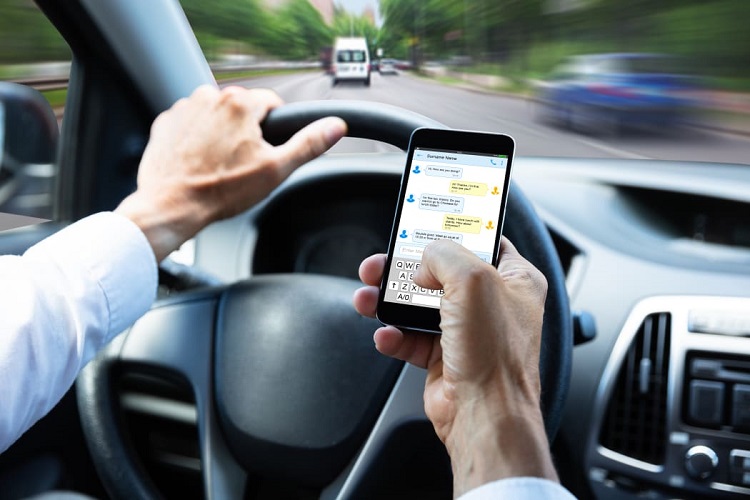
Any action that takes a driver's attention away from the road defines distracted driving. The most common kind of distracted driving is using a phone while driving. In the United States, there are about 1.6 million car accidents attributed to distracted driving each year.
You must give driving safely your whole concentration. It is dangerous for you and other drivers on the road to use a phone to text, make calls, seek directions, or for any other purpose.
There are three types of distracted driving: visual, cognitive, and manual.
The National Safety Council reported that 1.6 million car accidents occur each year as a result of distracted driving. Because there are so many minor collisions that are unreported to the police, this number might be significantly higher. As a result, they are not listed in the accident log. Accidents brought on by using a phone while driving resulted in more than 390,000 injuries. According to statistics from the National Safety Council, using a cell phone while driving results in 1 out of every 4 accidents in the US, which is more accidents than are brought on by drunk driving.
Just under 10% of drivers are reportedly using cellphones while driving at any given time, according to the Insurance Institute for Highway Safety (IIHS). As a result, if there are 100 other vehicles behind you in traffic, it is likely that ten of them will be using a phone.
Distracted driving, such as using a phone while driving, is risky and raises the possibility of an auto accident. 3,142 people lost their lives in car accidents in the US in 2019 where distraction was a contributing factor.
When compared to drivers who are not distracted, using a cellphone while driving increases the chance of an accident by two to six times. Using a phone while driving reduces reaction times, increases lane deviations, and keeps drivers' eyes off the road for a long time. Inattention blindness, or the inability to comprehend and react to items on the road that are in plain view, can affect even drivers who manage to "multi-task" and keep at least some focus on the road while using their phone.
Young adult drivers (16 to 29 years old) are more prone to drive while distracted. According to a report, 40% of high school drivers send texts or emails on their phones while operating a vehicle. Young adults between the ages of 20 and 29 made up more than one-fourth of distracted drivers involved in fatal collisions in 2018.
A report by the UK's department of transport claims that using a cell phone while driving resulted in 33 fatalities, 90 serious injuries, and 308 minor injuries in the UK in 2017. As I've already explained, since many accident instances are not reported to the police, these data may actually be far higher than what is stated. Visit our page statistics of the UK's road accidents to learn more about the incidents that occurred in the country from 2013 to 2018 and for more information on the number of accidents that occurred there throughout the previous years.
The use of cell phones while driving is prohibited in 24 U.S. states. In 2001, New York became the first state to forbid all drivers from using portable cellphones while driving. Similar legislation governing hands-free driving are now present in nearly two dozen states. In 48 states, it is illegal to text and drive. California passed a legislation prohibiting cellphone use while driving in 2009, but it still allows for hands-free or voice-activated phone use.
After a hands-free regulation was implemented, smartphone use by drivers in Washington, D.C., decreased by 41%. In the three years after the state of Connecticut passed a hands-free rule, the number of drivers using their phones fell by 65%. The IIHS claims that there is insufficient evidence to conclusively demonstrate that hands-free legislation has decreased the overall number of cellphone-related automobile accidents in the U.S. Hands-free rules have at least somewhat reduced the number of drivers who use a phone while driving.
Vehicle entertainment systems assist drivers focus on the road by hiding their phones from view, but overly complicated systems do not. Infotainment systems like Apple CarPlay and Android Auto, which let users pair their phones with their vehicles so they can make hands-free calls, play music, and obtain directions without ever having to touch their phones, have been quickly adopted by automakers.
Voice-activated infotainment systems have been shown to aid in keeping one's attention on the road. When utilizing voice commands to perform infotainment-related duties, drivers are said to maintain their eyes on the road for a greater percentage of the time than when performing the same actions with their hands. Voice-activated infotainment systems vary widely. Vehicle complexity varies from one type to another. Voice instructions that involve many steps, such those that ask you to say an address in several, are more distracting for the driver than voice commands that only require one step.
Globally, there are strict regulations against using a mobile phone. In the UK, using a cell phone while operating a vehicle can result in 6 penalty points and a £200 fine.